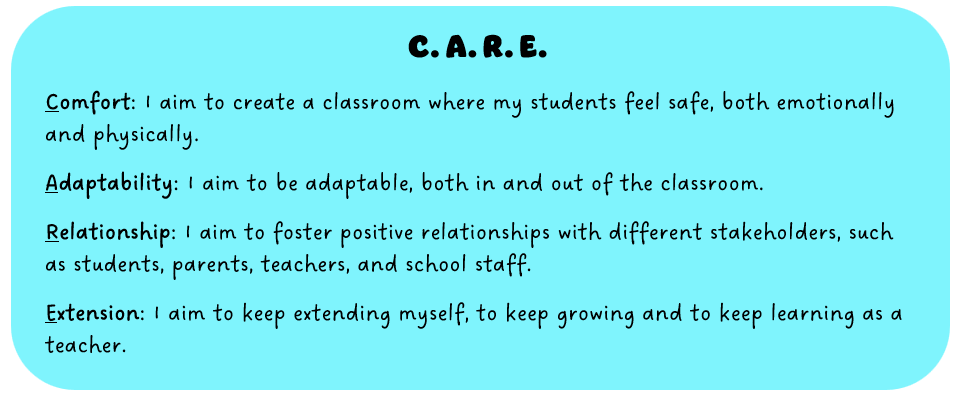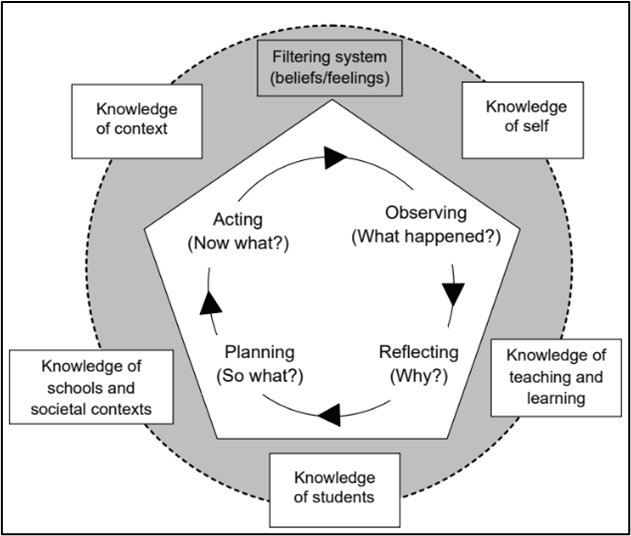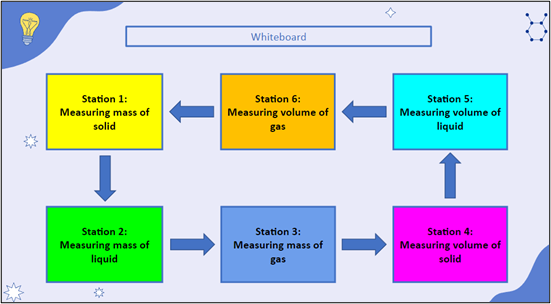The Journey Up The Mountain
The foot of the mountain
“Being a teacher really suits you since you are such a patient person!” People often responded that way when I told them I became a teacher in a primary school. That was what I also believed before I started my untrained teaching stint. If I was patient enough, I would be able to manage my students, right? That mindset quickly changed after I experienced more as a teacher. What makes someone suitable to be a teacher? If patience is not enough, what other traits do I need to develop to become a good teacher? At the end of my practicum, I felt like I was at the foot of a mountain that kept growing. To me, the summit was where I would have enough knowledge to feel confident, where all my questions would be answered and where the scenery would be the most beautiful. The summit was my end goal and what an ideal teacher looks like to me, but it was getting further and further away. The more I knew, the less I realized I knew. In this chapter, I will focus on the traits I hope to develop as a teacher to help me journey up the ever-growing mountain.
Trait 1: Care
Getting to the base camp of a mountain is already a feat. Having a strong foundation to ground myself helped me journey upwards. Being a Singaporean, I created an acronym for my teaching philosophy – C.A.R.E.

Caring for every one of my students is the most basic aspiration I have as a teacher, but what is care? According to the Oxford Learner’s Dictionaries, the word ‘care’ has four different meanings. Firstly, care is the process of providing someone with what they need for health and protection. My students should feel safe physically and emotionally in my classroom before they can even start learning.
Secondly, care means providing a home or a family for children who cannot live with their parents. In a less extreme situation in my classroom, some children spend more time in school than at home. Creating a safe haven for my students to learn and grow in is providing care for them too.
Thirdly, care is the attention or thought you give something that you are doing, such that you do it well and avoid damage. Respecting every student as individuals and putting in effort to make a positive impact on them is treating them with care.
Lastly, care is the feeling of worry. I worry and care about my students as they are precious. Civil rights activist Maya Angelou once said, “I’ve learned that people will forget what you said, people will forget what you did, but people will never forget how you made them feel.” How did I make my students feel while they were under my care? Did I inspire them to become a better person? Did I help them overcome their insecurities and believe in themselves? In summary, I believe that care is an important trait to have as a teacher and the sincerity I treat my students with will be felt by them.
Trait 2: Reflective
Being a reflective practitioner was emphasized in courses in NIE and in most frameworks that teachers use, such as the Four-Life Learning Model, Reflective Teaching Model, Graduand Teacher Competencies, Core Values, 21st century competencies and social-emotional competencies. At the start of my practicum, I doubted the importance of reflecting. Will it really help me? Is it just a section of my lesson plan that I need to complete? However, after the first week of teaching, I started to look forward to writing my reflections as I realized the impact it had on my teaching. I was more aware of my strengths and my areas of improvement and by actively acting on those areas, I saw myself growing and developing new strengths. Two specific lessons helped me believe in the importance of reflecting.
My first formal lesson observation for science did not go well. Armed with too many teaching aids, I was disorganized and that caused my students to be disorganized too. Routines for classroom management were not enforced properly and as a result, my students’ learning was compromised. I was greatly disappointed in myself, not because I would score badly for my lesson observation, but because I had let my students down. Being reflective meant that I did not stop there. Hence, I decided to use the Reflective Teaching Model as a guide (Figure 1). First, I wrote down my observations and thoughts of what went well and what did not. Then, I listed down the reasons why the lesson happened that way and came up with ways to overcome those challenges.

Figure 1: Reflective Teaching Model (Low et al., 2009) – A framework I used to ensure that my reflections were comprehensive and effective.
The next day, I went into my science classroom, armed with a set of routines to reinforce and clear instructions for my students to follow. Before I started my lesson, I apologized to the class. “Yesterday’s lesson did not go as well as I wanted it to. I am sorry for that and I will make my lessons better from now on.” I was honest with my students and they were clear about my intentions as their teacher. They understood my perspective of wanting them to learn well. Those simple sentences helped them understand that as their teacher, I have expectations and I reflect on my work too. By modelling my thought process for them, I hoped that my students would learn to reflect on themselves too. I also adjusted my teaching strategies to suit my students’ learning needs (Figure 2). From a more teacher-directed lesson, I transitioned to collaborative, student-centered work. That lesson was successful and my students learnt well. Those two lessons were enough for me to believe in being reflective.

Figure 2: These are the resources I used for the lesson on the next day, after I had reflected on my strengths and areas of improvements as observed during the previous lesson. Giving clear instructions and incorporating collaborative work maintained the students’ engagement throughout the lesson.
Being reflective is a trait that is required to fulfil two components of my teaching philosophy – being adaptable and extending myself. By being open to feedback, being introspective and being willing to act on the feedback, I will be able to learn and grow. Sometimes, the results of being reflective are not as instant and apparent, but the process helps me track my strengths and areas of improvement and helps me develop a love for the art of teaching.
Trait 3: Collaboration
As stated in my teaching philosophy, I believe that fostering positive relationships with the people around me will help me become a better teacher. Collaboration skills are part of the 21st century competencies that we hope our students develop and are skills that we teachers need to embody. Collaborating with students, other teachers, school staff and parents are important aspects of being an effective teacher. Teaching is a people-oriented profession and as the famous saying goes, it takes a whole village to raise a child.
Collaboration with others has many aspects. Collaboration is the act of working together with people to create a product. Continuing with my analogy of climbing a mountain, collaborating with others always makes the journey upwards easier. When I first stepped into my school at the start of practicum, I felt lost and did not know how to advance up the mountain. Having people around me, such as my Cooperating Teachers (CTs), my School Coordinating Mentors (SCMs), fellow teachers, Special Educational Needs Officers (SENO) and fellow NIE trainees, helped me find my sense of direction and that helped me make my journey up the mountain. For example, I received guidance from the SENO, my CT and even the previous subject teacher regarding a student with special needs in my class during practicum. Strategies were shared to help me manage certain behaviours and from that experience, I truly understood the effectiveness of working together as a school.
However, collaborative work is more than getting guidance and support from others. Just as how my colleagues gave me direction, I had strengths to contribute too, such as different teaching strategies, classroom management routines and technology-mediated strategies. For example, I adapted a science lesson to incorporate hands-on learning. Instead of the usual teacher demonstration, I organized a learning center, where students moved around different stations in their groups to complete hands-on work (Figure 3). I was encouraged to share my lesson resources with the department. I learnt that even though I was inexperienced, I was definitely still able to contribute and share my ideas, just like how I can still offer a fresh drink of water to an experienced mountain climber that I crossed paths with.

Figure 3: The learning centre that I conducted during a Science lesson for measuring the mass and volume of the three states of matter.
Another aspect of collaboration is forming positive relationships with others. However, before collaborating with others, it is important to have self-awareness, to know my boundaries and to understand myself. After completing the CliftonStrengths survey, I learnt that my top strengths involve traits such as harmony with others and positivity. Understanding that those are my strengths gave me the motivation to leverage on them and to contribute to the school in that aspect. The CCE framework often emphasizes maintaining a caring and enabling school environment and to achieve that, it always begins with the individual. Greeting the security officers in the morning, thanking the housekeeping staff, having a chit-chat with the canteen vendors, helping the administrative staff, having a laugh with the IT officers, going into class with a smile and sending positive messages to parents are all simple gestures that do not take up much energy, but go a long way in creating positive energy. Climbing up a mountain while sharing laughter with others is always better than climbing up alone in a dull mood, not just for myself, but for everyone around me.
Trait 4: Self-awareness
Lastly, I believe that in order to achieve the above traits, it is important to understand my own strengths and areas of improvement. My school supports us in this area by getting us to take a CliftonStrengths survey. After the survey, I found out my top five strengths – positivity, harmony, developer, responsibility and includer. Interestingly, four out of five of these traits fall in the domain of relationship building. Using this knowledge, I became more aware of why I formed my teaching philosophy to focus on character development more, instead of academic development. While academic development is important, as a teacher and as an individual, I personally believe in the strength of positive relationships and building character. Understanding my strengths will help me contribute better to my school and will help me understand what kind of teacher I aspire to be.
The summit of the mountain
While I have listed traits that I prioritise at this stage of my journey, there is still a bigger question. What kind of teacher do I aspire to be? What lies at the summit of the mountain that I am trying to climb? Besides answering the questions I have now and being more knowledgeable in this profession, I want to be a teacher who leaves a positive impact on my students’ lives. We have all heard of the story of the boy returning a sea star back to the ocean because he believed that even though it does not make much difference to the world, it makes a world’s difference to that sea star. This may sound clichéd, but over time, I have learnt the impact I have on my students and the weight of my words in their lives. To them, I am a mentor that they trust and listen to. I am someone who can help change their lives for the better. Being mindful of the responsibility that I have, I hope to continuously learn and grow into the teacher I aspire to become so that I can better help my students.
The journey up the mountain
In December, the month before my practicum started, I was on vacation in Bali, Indonesia. At 3 a.m. in the morning, I started to climb Mount Batur. The goal was to reach the top in time and watch the sunrise at the summit. I managed to catch the breathtaking sunrise (Figure 4a), but what I saw on my climb up surprised me more. It was dark and I was focused on maintaining my balance on the rocks beneath me. At some point, I decided to look up. The dark sky was filled with so many stars and at that moment, I told myself that even if I do not manage to reach the summit, I would still be more than happy. The view on the way up was equally stunning (Figure 4b). We always hear that the journey matters more than the goal and that the process is equally, if not more, important that the product. After that experience, my perspective on the mountain changed. It was no longer something to be conquered, but something to be enjoyed. If I appreciate the opportunities to learn and the opportunities to see my students laugh and learn, I will definitely enjoy the process too.

Figure 4a (left): This photograph does not show the grandeur of the night sky and how bright the stars shine at night.
Figure 4b (right): The stunning sunrise at the summit of the mountain.
References
Low, E. L., Taylor, P. G., Joseph, J., & Atienza, J. C. (Eds.). (2009). A teacher education model for the 21st century. Singapore: National Institute of Education.














/enri-thumbnails/careeropportunities1f0caf1c-a12d-479c-be7c-3c04e085c617.tmb-mega-menu.jpg?Culture=en&sfvrsn=d7261e3b_1)

/cradle-thumbnails/research-capabilities1516d0ba63aa44f0b4ee77a8c05263b2.tmb-mega-menu.jpg?Culture=en&sfvrsn=1bc94f8_1)
